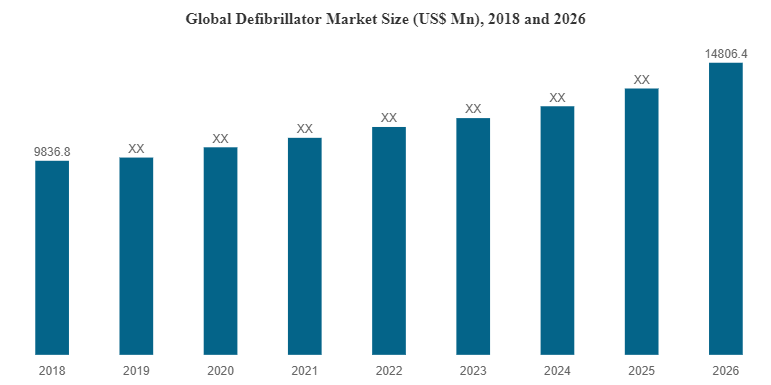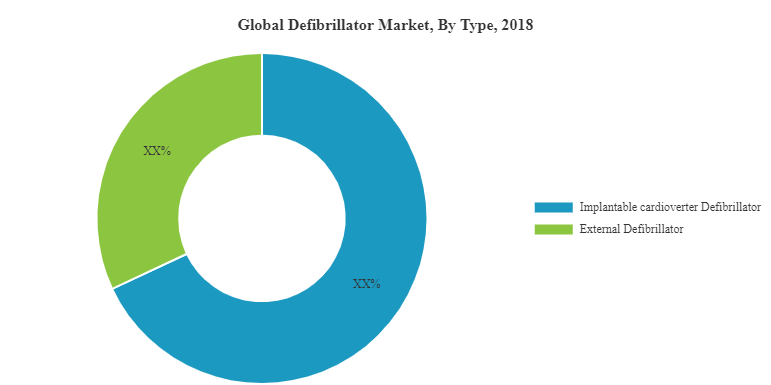Home / Healthcare / Medical Device / Defibrillator Market
Defibrillator Market Size, Share and Industry Analysis By Type (Implantable Cardioverter Defibrillator (ICD), Transvenous ICD, External Defibrillator) By End User(Hospitals & Clinics, Ambulatory, Schools and other Public Places) and Regional Forecast, 2019 - 2032
Report Format: PDF | Latest Update: Jun, 2024 | Published Date: Jul, 2019 | Report ID: FBI100950 | Status : PublishedThe global defibrillator market size was valued at USD 9,836.8 Million in 2018 is projected to reach USD 21,184.6 Million by 2032, exhibiting a CAGR of 5.7% during the forecast period (2018-2032). North America dominated the global market with a share of 44.87% in 2018.
Defibrillation is an effective treatment option which is accepted globally in order to treat cardiac arrest occurred due to ventricular fibrillation. A defibrillator incorporates the concept of defibrillation, is an electronic device, which is prominently used to treat the arrhythmia and sudden cardiac arrest.
According to data published by the National Institutes of Health in 2016, an estimated 450,000 people suffer due to sudden cardiac death. Since the prevalence and incidence of out-of-hospital cardiac arrest are increasing, developed as well as emerging nations are strictly focusing on installations of external defibrillators in public places such as schools, hotels, shopping malls, streets, and others. Combined with this, education is being offered in schools to spread awareness about them amongst children with the aim to deal with cardiac arrests, which is expected to offer a significant amount of opportunity for the growth of the defibrillator market by 2026.

Market Segmentation
"Increasing Prevalence of Sudden Cardiac Arrest is Anticipated to Drive the Defibrillator Market "
Increasing prevalence of out-of-hospital cardiac arrests and comfort offered by external defibrillators is expected to boost the defibrillator market growth during the forecast period. Moreover, strict government regulations in developed nations are propelling the installations of external defibrillators in public places. In 2014, Asahi Kasei Corporation launched LifeVest, wearable defibrillator in certain parts of the world.
A wearable defibrillator is programmed in such a way that; it can predict the risk of sudden cardiac arrest even before it occurs. Additionally, the safety of external ones as compared to an implantable defibrillator in terms of lead poisoning and inappropriate shocks is projected to increase the adoption of an external defibrillator during the forecast period. At present, implantable cardioverter defibrillator holds a significant share of the market.

In terms of types, the market segments includes implanted cardioverter defibrillator (ICD) and external defibrillator. The latter segment held an estimated 32.0% of the share in the market in 2018. In terms of external ones, the market is categorized into automated external defibrillator (AED), semi-automatic and manual external defibrillator, and wearable external defibrillator. In terms of implantable cardioverter defibrillator, the market is categorized into transvenous ICD and subcutaneous ICD.
Transvenous ICD is further categorized into single-chamber ICD, dual chamber ICD and CRT-D (cardiac resynchronization therapy- defibrillator). The CRT-D accounted for maximum market share in 2018, owing to the higher adoption of the device and higher acquisition cost, most prominently in developed countries. Additionally, the hospitals & clinics in end user segment are expected to register comparatively higher the defibrillator market revenue owing to the higher prevalence of sudden cardiac arrests.
Regional Analysis
"Higher Adoption of Defibrillator Installations as well as Implants Enables Market to Hold Considerable Share in North America"
North America generated revenue of USD 4,414.1 Million in 2018 and is expected to dominate the market throughout the forecast period. Growing installations of external defibrillators in hospitals, as well as public places such as schools, hotels, streets, railway stations, and others with the aim to prevent fatalities from sudden cardiac arrest, is prominently responsible to hold a higher defibrillator market share in North America.
Moreover, the gradual shift of preference towards subcutaneous ICD due to increasing patient awareness is projected to boost the growth of ICD in North America. Europe is anticipated to be the second most prominent region in terms of revenue by 2026. The market is rising at faster pace in emerging countries of Asia Pacific region, owing to rising adoption and rapidly developing healthcare infrastructure.
Key Market Drivers
"Medtronic to Account for Significant Share of the in Terms of Revenue"
Medtronic is a leading player in defibrillator market and estimated to retain its position in the forecast duration owing to its diverse product offering in implantable defibrillator segment, efficient customer reach, and strong after-sales service. This company, together with Boston Scientific Corporation currently holds over half of the market share in terms of revenue. Other players operating in the defibrillator market are Cardiac Science, Physio Control, Stryker, Defibtech, LLC., CU Medical Systems Inc., Abbott, Boston Scientific Corporation, LivaNova PLC, MicroPort, and BIOTRONIK.
List of Companies Profiled
- Asahi Kasei Corporation
- Philips Healthcare
- Defibtech, LLC.
- Cardiac Science
- Stryker
- CU Medical System Inc.
- Medtronic
- Boston Scientific Corporation
- Biotronik
- LivaNova Plc
- Abbott
- Microport
- Other prominent players
KEY INDUSTRY DEVELPMENTS:
- July 2021 - ZOLL Medical Corporation, announced that the company has received clearance from FDA 510(k) to release the TBI (traumatic brain injury) Dashboard feature on its Propaq M monitor and Propaq MD defibrillator. This feature provides clinical decision support for managing patients with TBI and was available in international markets but with the FDA clearance it is now available in U.S. market.
- March 2021 - The Rankin government made an announcement that all public schools in Nova Scotia a will be provided automated external defibrillators. The government made an investment of USD 700,000. The purpose of this investment is the availability of these devices at the time of cardiac emergency.
- April 2020 – Philips, a health technology, made an announcement that its Emergency Care and Resuscitation (ECR) business is recommencing manufacturing and shipping of external defibrillators for the US. Company notified that the US Food and Drug Administration (FDA) had lifted the restrictions imposed on the manufacturing and distribution of defibrillators in US.
Report Coverage
Electrical cardioversion and defibrillation play a vital role in the treatment of dysrhythmia. Technological advancements in implantable as wearable ones are responsible for its dramatic increase in adoption during the past decade. Additionally, the rapidly increasing prevalence of arrhythmia across the globe is projected to offer significant growth opportunity for implantable cardioverter market by 2026.
The report provides qualitative and quantitative insights on the global defibrillator market trends and detailed analysis of the market size and growth rate for all possible segments in the market. The market segments include type, end user, and region. On the basis of the type, the market is segmented into implantable cardioverter and external defibrillators. Various end users covered under the report are hospitals & clinics and schools and other public places. Geographically, the market is segmented into four major regions, which are North America, Europe, Asia Pacific, and the rest of the World. The regions are further categorized into countries.
Along with this, the report analysis provides elaborative analysis of the defibrillator industry dynamics and competitive landscape. Various key insights provided in the report are the prevalence of sudden cardiac arrests in key countries, technological advancements, recent industry developments such as mergers & acquisitions, the regulatory scenario in key countries, new products launches, reimbursement scenario, and key industry trends.
SEGMENTATION
ATTRIBUTE |
DETAILS |
By Type |
· Implantable Cardioverter Defibrillator (ICD)
o Single Chamber ICD o Dual Chamber ICD o CRT-D (cardiac resynchronization therapy- defibrillator)
· External Defibrillator
|
By End User |
· Hospitals & Clinics · Ambulatory, Schools and other Public Places |
By Geography |
· North America (USA and Canada) · Europe (UK, Germany, France, Italy, Spain, Scandinavia and Rest of Europe) · Asia Pacific (Japan, China, India, Australia, Southeast Asia and Rest of Asia Pacific) · Rest of the World |
Frequently Asked Questions
What was the size of the global Defibrillators Market in 2018?
Fortune Business Insights says that the value of the global Defibrillators Market was USD 9,836.8 Million in 2018.
How much will the global Defibrillators Market be worth in the future?
The Defibrillators Market is projected to reach USD 14,806.4 Million by 2026.
At what compound annual growth rate (CAGR) will the global Defibrillators Market grow?
The Defibrillators Market will grow at the rate of 5.3% CAGR.
- Global
- 2018
- 2014-2017
- 115


